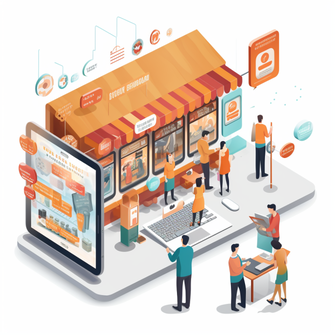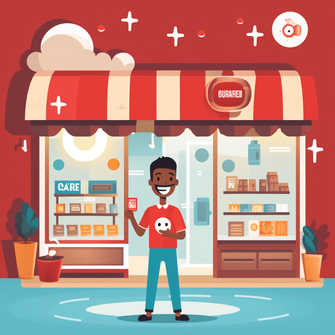11 Simple E-commerce Tips to Maximize Your Company’s Profit
Posted on 2023-11-17
Introduction

We've spent over 10 years working with eCommerce businesses of all kinds. We've seen what separates the good ones from the rest. Here, we have gathered 11 actionable e-commerce tips that will help your business join the former and make more money.
2. Work on Your Product Feed

Having a well-organized product feed is important for two main reasons.
- It will make it easier to monitor your inventory.
- Your Shopping Ads will work better.
To make your product feed better:
- Add Info: Make sure your product names, descriptions, and pictures are clear, attractive, and authentic. The more useful info you provide, the more likely customers are to buy.
- Keep It Current: Update your product feed regularly to reflect any changes in price or stock, and to add new products. This keeps your ads and stock levels correct.
- Use Keywords: Include keywords in your product names and descriptions. This helps your products show up in search results and can make your ads work better.
To read more about setting up your product feed, check out our guide on how to do it using DataFeedWatch.
3. Advertise Your Product

Advertising is important for eCommerce marketing. The best platform depends on the product, but Google Ads and Facebook Ads are commonly used in eCommerce industry and generally yield good results.
Run Ads on Multiple Platforms
Don't stick to one platform for ads. Use a few, like Facebook, Instagram, Google, or Pinterest. This way, more people can see your products. Different sites work better for different things, so try them out.
Use Shopping And Catalog Ads
Shopping and Catalog Ads show your products directly in the search results or social media feeds. This gives people a quick look at what you're offering.
For Google Shopping Ads, you need to put your product feed into Google Merchant Center. Then Google will show your products to people searching for similar items.
On Facebook and Instagram, Catalog Ads show your products in users' feeds. You make a catalog on these sites, and they show your products to users based on what they like.
This type of ad can work better than just text because people can see what they're getting. This makes them more likely to buy.
Use Retargeting Ads
Regain customer interest by retargeting abandoned shopping carts. This strategy often has a higher conversion rate than emails sent for the same purpose. Potential customers who hesitated initially are more likely to purchase with the help of retargeting ads.
5. Make Use of Search Engine Optimization

After auditing over a thousand websites and analyzing the data, we've discovered one interesting fact. Organic traffic is the largest source of traffic and conversions for almost all successful eCommerce businesses.
So if you want to make money, SEO is not optional.
Target Specific Keywords
Lots of online shops focus on quick wins and forget about long-term plans like SEO. A good SEO plan, which includes choosing the right keywords, is important. Yes, SEO takes a lot of time and money, but it helps bring more people to your site naturally. And, if your ad account runs into issues, SEO can keep people coming to your site.
Enhance Search Usability
On-page SEO is crucial for making your e-commerce site more visible to search engines. Here are some areas to concentrate on:
- Keyword Optimization: Make sure you include your target keywords in key places on your page like the title tag, header tags (H1, H2, etc.), and throughout the content.
- Meta Descriptions: Create compelling meta descriptions for each page. This is the text that appears below your page title in search engine results and should entice users to click on your link.
- URL Structure: Keep your URLs simple and relevant. They should be easily understandable both for your users and search engines.
- Internal Linking: Link between different pages on your site. This helps search engines understand the content of your site and can improve your site's visibility in search results.
- Image Alt Text: Search engines can't 'see' images - they rely on alt text to understand what an image is about. Make sure all your product images have relevant alt text.
Create a Blog
Starting a blog helps your eCommerce website in a few ways. It helps with SEO because you can use more keywords that are related to what you sell. It gives you chances to link to other parts of your site, which also helps with SEO.
Plus, a blog can make people trust your brand more. You can share news, tips, and your thoughts about your industry. People like to buy from brands they trust, and a blog can help with that.
6. Use Email Marketing

Despite rumors of its demise, email marketing remains a powerful tool. It enables you to interact with your customers effectively.
Set up Essential Email Marketing Flows
- Welcome Emails: Send a friendly hello to new subscribers. Tell them about your shop and maybe offer a first-time buyer discount.
- Cart Reminders: Send reminders to customers who leave items in their cart. This helps turn forgotten carts into sales.
- Thank You Emails: After someone buys something, send a thank you email. You can ask for reviews or suggest other items they might like.
- Wake-Up Emails: For people who haven't clicked your emails in a while, send them something special. This can remind them of why they liked your shop.
- Personal Suggestions: Send emails suggesting products based on what a customer has looked at or bought before.
Grow an Email List
Neglecting email marketing is a missed opportunity. Use signup forms and incentives like discount codes to collect email addresses. To avoid ending up in spam, build trust before sending emails. Place signup forms at the end of blog posts or tutorials. If your content is helpful, website visitors are likely to share their emails, especially if they see potential offers.
7. Optimize Your Website

You need to make regular tweaks to your eCommerce store to optimize sales.
Make Use of Personalization
Personalization is a key way to boost sales. This means showing products, offers, or suggestions based on a customer's past actions or interests. You can use cookies or account info to learn about what a customer likes. Then, show them things that match their interests. This makes shopping more enjoyable for them, and they're more likely to buy when they see things they like. Plus, it makes them feel like your online store understands and values them.
Implement Live Chat
Live chat supports customers in making swift decisions by providing instant access to readily accessible information. To humanize your website, ensure customers feel like they're conversing with real people, not bots. The live chat button should be visible at all times.
Enrich with Photos and Videos
Ensure your site is visually appealing. Use multiple high-quality images for products and other sections like blogs. An eye-catching banner helps the buyer visualize using the product.
We've only listed the most basic things here. In reality, conversion rate optimization tends to be more complicated. If you want a comprehensive approach, you might want to contact us. Our action plan for optimizing websites includes around 100 steps, and it works 100% of the time.
8. Promote Your Product

Promoting products is different from ads and usually more sales happens on the product pages. Here are some simple tips to get more customers and increase sales:
Give Free Delivery
First, you need to include shipping info to encourage customers and help with online sales. Then, offer free delivery, especially to places near you. People love to buy online when delivery is free.
Start a Rewards Program
A rewards program makes customers loyal. It's a way to make sure they keep buying what they like. It could be quick access to free stuff or other perks.
Upselling, Quick Sales, and Discount Codes
A successful business knows which promotions help its customers most. Sell more of your products, use banners for quick sales, and give discounts on usual order prices. These things make customers want to keep buying from your online shop.
9. Keep Your Pricing Adaptable

A key tip for online shops is to always keep making a profit. Don't try to sell things cheaper than your competitors. It won't work.
Sell products to customers at a fair price. Often, the first business that a customer sees wins.
For dropshipping on Amazon, for example, the lowest price usually wins. If you're competing with other dropshippers on Google Shopping for the same items, you'll also want to offer the lowest price.
In the competitive world of eCommerce, it's important to monitor market prices regularly. This is where SaaS solutions for price monitoring can be a game-changer for eCommerce brands. Services like Prisync, Price2Spy, and Competera can track your competitors' prices and stock availability in real-time, allowing you to adjust your pricing strategy accordingly.
Adaptability is key. If a challenge threatens your profits, find a solution. Use the tools at your disposal and strategize to stay ahead in the game.
10. Use OKR for Your Business

OKR stands for Objectives and Key Results. This framework is used by many successful businesses to set and track goals. It helps keep your company focused and aligned.
Objectives are what you want to achieve. They should be clear, actionable, and inspiring. Key Results are how you measure progress toward the objective. They should be quantifiable, achievable, and lead to objective grading.
For example, an Objective could be "Increase website traffic," and Key Results could be "Achieve 20% more daily visitors" and "Decrease bounce rate by 10%."
Setting clear OKRs can give you and your team a sense of direction and purpose, which can motivate everyone to work hard and increase sales.
11. Develop Effective Customer Retention Strategies

Work on strategies to keep your customers coming back.
This can include a loyalty program that offers rewards for repeat purchases, personalized offers based on their shopping habits, or excellent customer service.
Regularly reach out to your customers through emails or social media to keep your brand fresh in their minds. Remember, it's often cheaper to keep a customer than to find a new one.
Conclusion
Selling products and making money isn't easy, especially for new businesses. You'll face many challenges, like setting prices and getting sales. But, using the eCommerce tips in this article, you'll overcome these issues, make more money, and build a strong reputation!
Frequently Asked Questions
1. How can I compete with other online retailers, like those on Amazon or Google Shopping?
Competing online isn't just about pricing, it's also about the value you provide. By offering unique product features, high-quality items, and excellent customer service, you can differentiate yourself from others. Also, providing comprehensive product information, high-quality images, and responsive customer support can help you stand out.
2. How can I maintain a positive profit margin while offering competitive prices?
It's a delicate balance to maintain. You must understand your costs, including production, operation, and marketing costs, and set prices that can cover these and still make a profit. Finding cost-effective suppliers and efficient operations can help maintain profits while still offering competitive prices to new customers.
3. What should I do if I encounter a problem that could impact my profit?
Business is about adaptability. If a problem arises that could affect your profit, consider looking for alternative suppliers that offer better costs, improving your marketing strategy to reach more customers, or adjusting your pricing structure if necessary. Don't hesitate to rethink and revise your strategies as needed.
4. How can I increase my sales without changing my prices?
Boosting sales without price changes often comes down to marketing. Use social media ads to reach a wider audience, feature in blog posts to increase visibility, and improve your website's SEO to attract more organic traffic. Also, providing excellent customer service and user experience can boost sales and make customers more likely to buy and recommend your business to others.
5. What does it mean to make my goals 'achievable' and 'realistic'?
Achievable and realistic goals are within your reach, considering your resources, time, and capabilities. They should challenge you, pushing you to improve and grow, but not be so lofty that they're impossible to attain or demotivating. For instance, doubling your sales in a month might be unrealistic, but increasing them by 10% could be an achievable goal.
6. What is the importance of deadlines when setting my goals?
Deadlines offer a timeline and a sense of urgency, helping you focus on the task at hand. They prevent procrastination, keep you on track, and provide a clear endpoint for measuring success. Without deadlines, goals can often remain unachieved.
7. How can I keep my customers coming back?
Keeping customers returning involves fostering customer loyalty. This can be done through excellent customer service, regular product updates, and loyalty programs that engage customers further. These programs can provide rewards, discounts, or exclusive offers to repeat customers, making them feel valued and encouraging future purchases.
8. How can upselling and flash sales contribute to my sales?
Upselling involves encouraging customers to buy a higher-priced item or add-ons, increasing the overall purchase value. Flash sales create urgency, pushing customers to buy immediately to benefit from the limited-time offer. Both strategies can effectively boost your sales when used correctly.
9. Why should I start a rewards program?
Rewards programs incentivize customer loyalty by offering them exclusive benefits or perks. This can include discounts on future purchases, access to new products, or even free items. It makes customers feel valued, encourages them to continue buying from you, and can lead to increased sales and customer retention over time.
10. Why are SMART goals important in e-commerce?
SMART goals (Specific, Measurable, Achievable, Realistic, and Timed) provide clear, actionable objectives to aim for. They help maintain focus, track progress, and measure success effectively. Without SMART goals, your e-commerce strategy may lack direction, making it harder to achieve your business aims.









